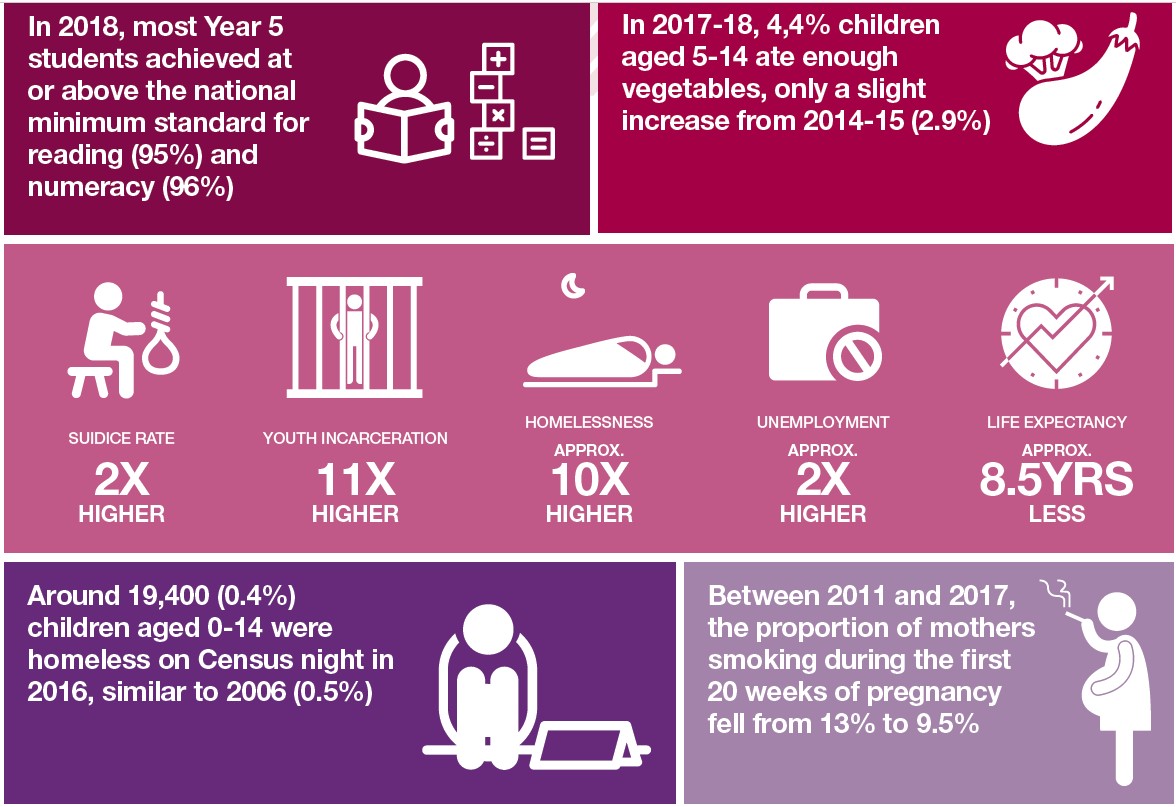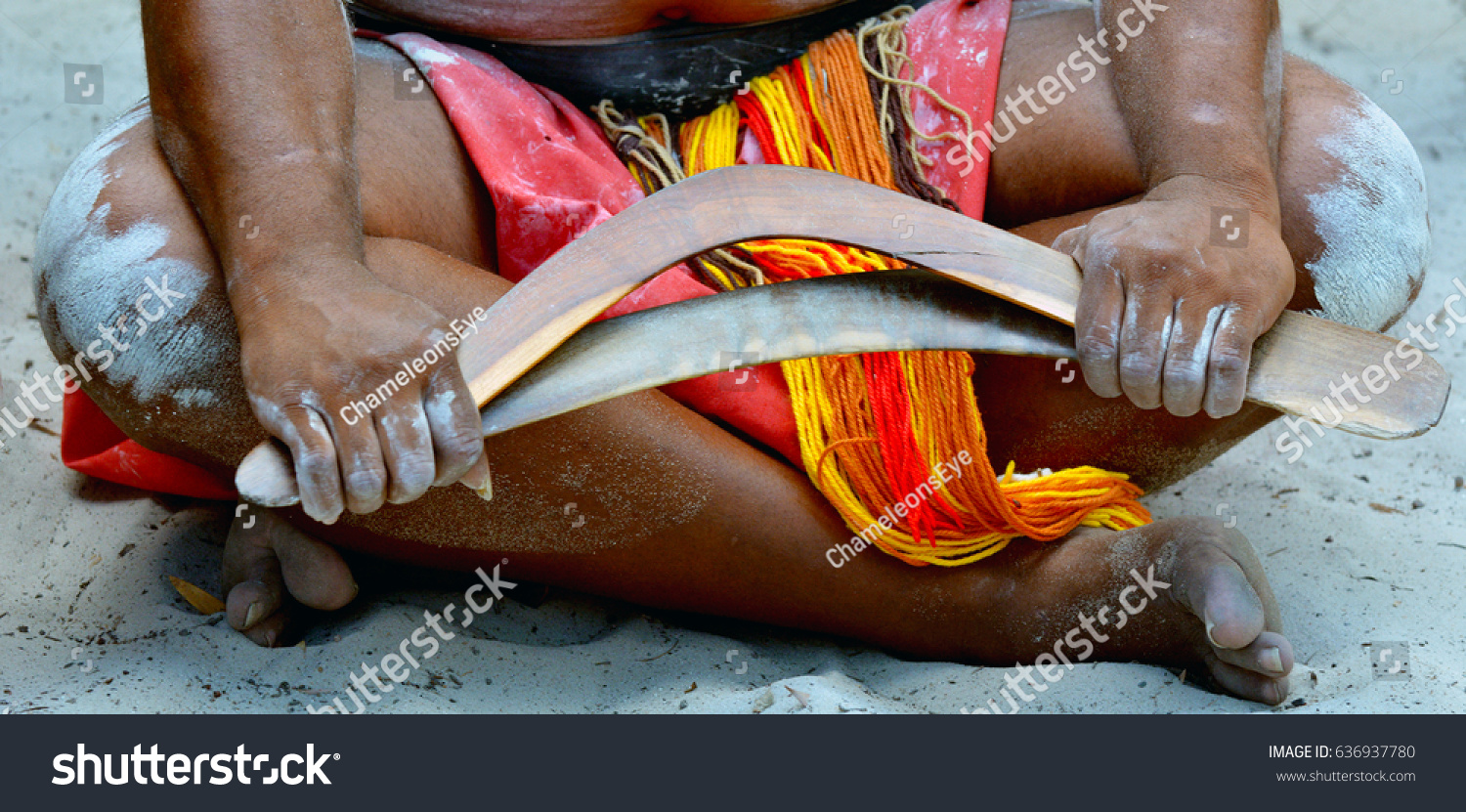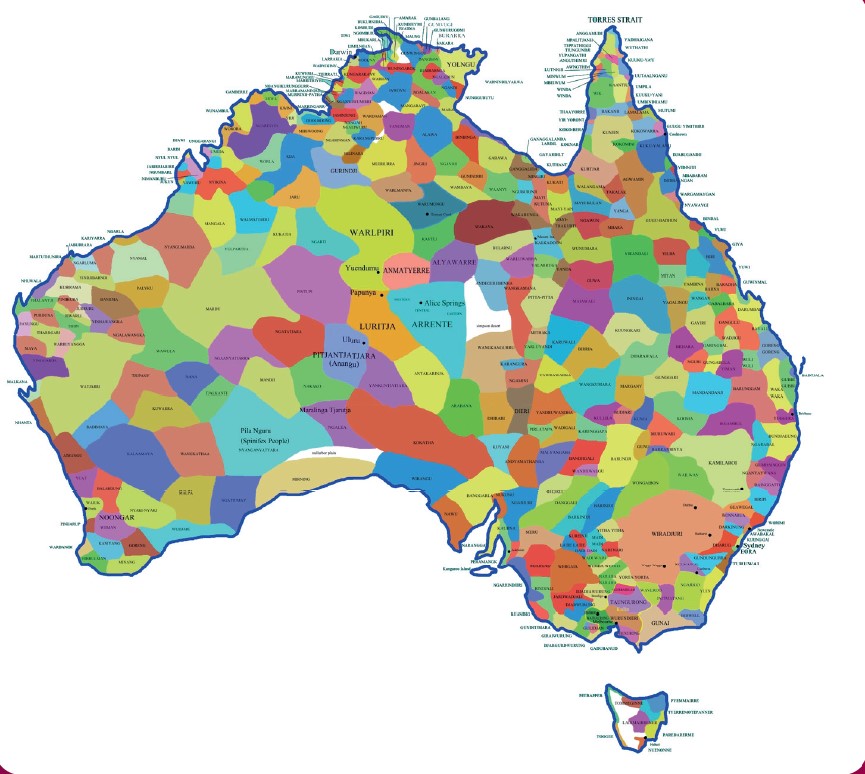In order to become a culturally safe workplace and one that provides appropriate programs for wide community, it is paramount to first understand the history of the Aboriginal and Torres Strait Islander peoples. It is important for community services workers to understand the experiences of Aboriginal and Torres Islander peoples and the impacts these experiences have had on their lives. Community services must reflect on their own understanding and potential biases and embrace cultural competence and culturally safe practices in the workplace.
By the end of this chapter,you will understand:
- parts of the history of Aboriginal and Torres Strait Islander peoples
- more about the experiences of Aboriginal and Torre Strait Islander peoples
- the impacts of these experiences on Aboriginal and Torres Strait Islander peoples.
The histories of the Aboriginal and Torres Strait Islander peoples are often complex and traumatic. Many years on, intergenerational trauma continues to impact families, leading to lifelong adversity. We will cover areas of the histories of these communities below to help better understand the impacts on these generations and their families.
European Settlement
In 1770, Captain James Cook sailed to Australia and claimed possession of the land. At this time, Britain was looking for a solution for its prison overcrowding issue. Cook’s voyage encouraged the authorities of Britain to establish Australia as its southern land base, to be used as a penal colony. Meanwhile, the custodians of the world’s oldest living culture of more than 60,000 years, comprising over 500 Aboriginal and Torres Strait Islander groups, had lived peacefully in close physical and spiritual connection to the land.
In 1788, Captain Arthur Phillip returned to set up this penal colony. Within 10 years, the population of Aboriginal people dropped form 750,000 by 90%.
Reasons for this dramatic decline in population included:
- Disease brought by the European colonisers
- Murder and conflict over land and resources
Terra Nullius
The way of life for Aboriginal peoples was vastly different to that of the European colonisers. This difference meant that, in the eyes of the colonisers, Aboriginal peoples could be classed as ‘non-human’. This denial of Aboriginal peoples humanity allowed the colonisers to declare the land of Australia as terra nullius, which means ‘nobody’s land’ or ‘land belonging to no one’, a land that is not owned or used by anyone. This led to a take-over without a treaty or payment, and denied Aboriginal and Torres Strait Islander peoples their connection to the land. The definition of terra nullius was later revoked after Eddie Mabo pushed a legal case against the Commonwealth of Australia for a decade. After his death, a decision was finally handed down stating that the previous law:
- Defied and violated human rights
- Denied Aboriginal and Torres Strait Islander histories and dispossession.
The new law encompassed that:
- Aboriginal Australians have a prior claim to the land that had been taken by the Crown
- The declaration of terra nullius, which allowed the British to state their ‘rights’ to claim the land, was a false claim and based on legal and historical fiction.
| Read |
|---|
| Read about how the legislation of the Mabo case has fared from 1992 to 2020: ‘28 years since Australia’s historic Mabo decision, “there is a lot of unfinished business”’ from SBS News https://www.sbs.com.au/news/article/28-years-since-australias-historic-mabo-decision-there-is-a-lot-of-unfinished-business/nvhqq8raz |
Watch
Watch this YouTube video, Who We Are: People (8:17) to learn more information about First Australian peoples: ‘First Australians’ by ReconciliationAus
Watch
Watch this YouTube video, Family and kinship (2.44) about kinship systems for Aboriginal and Torres Strait Islander peoples: ‘Family and Kinship’ by ReconciliationAus
| Activity 1A |
|---|
|
Aboriginal and Torres Strait Islander Peoples Identity and Geography View the map below of Aboriginal tribes in Australia, and compare it to the map of Australia today. Find where you live and the identify the tribe whose land you inhabit. Research and learn more about your tribe or mob.
Source for image: Map, from Connection and Wellbeing - (https://connectionandwellbeing.com.au/ start-the-conversation/)
|

Due to the loss of land, loss of connection to land and the violent take over by the British, the Aboriginal peoples began to lose their culture either by force (assimilation) or though loss of population as their stories became lost. From the 1780s, countless Aboriginal people were massacred, removed from their communities and forced into missions, farms and reserves. Here they were forced to work, often under abuse and heavy surveillance, and were further de-identified from their communities and families. The taking of Aboriginal and Torres Strait Islander children from their homes has henceforth become known as the Stolen Generations.
This was another area of the European’s assimilation policy that aimed to breed out Aboriginal culture, colour and identity of the people. Children were adopted or placed into institutions where they were often abused, traumatised and ordered to disassociate themselves from their family and culture by the white population.
| Read |
|---|
| Read this article about identity by Aboriginal journalist, reporter and presenter Stan Grant: ‘We are trapped in the imaginations of white Australians’ https://www.theguardian.com/commentisfree/2015/dec/14/the-politics-of-identity-we-are-trapped-in-the-imaginations-of-white-australians |
Watch
Watch this ABC Education clip about Aboriginal and Torres Strait Islander identity, history and culture; you may even see Stan Grant again: ‘Cultural Identity’ from ABC https://www.abc.net.au/education#!/media/3415263/culture-and-identity
Connect the video above with this clip about ‘The Australian Dream’: ‘The Australian Dream’ from ABC https://www.abc.net.au/education#!/topic/3414926/the-australian-dream/video
Watch this YouTube video about Dadirri and the practice of Deep Inner Listening: ‘Dadirri’ by MiriamRoseFoundation
Assimilation
Assimilation is the act of or taking in the ideas, language, culture and ways of being of another peoples and adopting this in practice. In assimilation the society’s dominant culture and practices are emphasised and strengthened, weakening the culture and practices of the minority. This is evident in the histories of Aboriginal peoples; as a minority group, their values, cultures, languages and ways of life have disappeared as they have integrated into the society of Australia’s white majority.
The assimilation policy of Australia informed that it would only take three generations to breed out Aboriginal colour and culture, as shown in the above image from A.O Neville’s book Australia’s Coloured Minority.
| Read |
|---|
| Read more about the history and stories of Australia’s First Peoples as shown at this exhibition at the Australian Museum in 2015: ‘Indigenous Australians: Australia’s First Peoples exhibition 1996-2015’ from The Australian Museum https://australian.museum/about/history/exhibitions/indigenous-australians/ |
Watch
Watch this YouTube clip of scene from Rabbit Proof Fence showing the three-generation program and demonstrating A.O Neville in his role as ‘protector of the Aboriginals’:‘Mr Neville scenes’ from Ann Angermuller
Watch the following video by The Healing Foundation titled ‘Telling Our Stories – Our Stolen Generations (Florence Onus)’:
| Actiity 1B | |
|---|---|
|
A Reflection on European Settlement Consider what you have learned so far. Now, think about the place where you currently live, or maybe your home as a child. Imagine strangers coming into your home and never leaving. They tell you that you can’t be who you think you are and that the only way you can survive is to leave your home and work for another person for free, enduring frequent abuse in the process. Your children will be given away to someone else, as these people believe they can look after them better than you. They develop these policies that governs your life without ever getting to know you or anyone in your community. You will most likely never see your family again and there is a high chance that around half your family will fall under the fatality rate that comes with the diseases and inhumane treatment brought by these strangers. Reflection questions |
|
| 1. | Does this seem just? |
| 2. | How may this experience impact on you and your family for generations? |
| 3. | Do you think it would quick and easy to 'get over' this experience? |
| 4. | Do you think you would ever feel trust towards these people and their future generations? |
| 5. | Would you continue to feel angry? |
| 6. | Would you feel resentment to their brutality and the impact they have had on your entire family? |

When a society ostracises a group, body or person from the networks, connections, opportunities and assistance available to the majority group, this is called exclusion.
Aboriginal people in Australia have been excluded from access to medical care, the education and employment opportunities and basic human rights that majority white Australians enjoy. Consider this, knowing that white colonisers brought with them many of the diseases and causal agents of death that Aboriginal people still struggle with.
Issues that still impact Aboriginal populations today include high levels of poverty, incarceration and homelessness, poor health and educational outcomes, and high levels of unemployment.
Today there are still many problematic perceptions of cultural groups, hence, impacting how they are treated. Watch the clips below showing how children (and adults) view race, and how exclusion and assumptions can lead to ongoing discrimination and prejudice, even among children. ‘Exclusion is an invisible disease’ by Ronna Timpa from TED Talks
‘Doll test - The effects of racism on children’ by Fanpage.it
‘Kids speak their minds about race’ by CNN
‘Uniting | My home’ by Uniting
‘The dangers of a single story’ by Chimamanda Ngozi Adichie from TED
United Nations Convention on the Rights of the Child (1991)
The United Nations (UN) created the human rights treaty for children over 30 years ago, which developed an international agreement on the rights of childhood, helping to transform the lives of children around the world.
| Read |
|---|
|
Read the following documents to learn more about the UN Convention on the Rights of the Child, and about Australian education school policies and discrimination laws in Australia: ‘A simplified version of the United Nations Convention on the Rights of the Child’ by UNICEF https://assets-us-01.kc-usercontent.com/99f113b4-e5f7-00d2-23c0-c83ca2e4cfa2/fc21b0e1-2a6c-43e7-84f9-7c6d88dcc18b/unicef-simplified-convention-child-rights.pdf |
| ‘A quick guide to Australian discrimination laws’ by the Australian Human Rights Commission. https://humanrights.gov.au/our-work/employers/quick-guide-australian-discrimination-laws |
| ‘Discrimination at school’ by Youth Law Australia https://yla.org.au/vic/topics/school/discrimination/ |
| ‘Indigenous education’ by the Department of Education, Skills and Employment https://www.education.gov.au/indigenous-education |
Watch
Watch the following videos to learn more about a child’s right to play: ‘UNCRC Article 31 (leisure, play and culture)’ by Young Person’s Advisory Service
‘This Is Me: Article 31 and a Child’s Right to Play’ by International Play Association (IPA World)
The Declaration on the Rights of Indigenous Peoples (2007)
The Declaration on the Rights of Indigenous Peoples is the most comprehensive international instrument on the rights of Indigenous peoples. It took many years for the UN to reach a unanimous vote of agreeance.
| Note |
|---|
| The United Nations states that the declaration: … establishes a universal framework of minimum standards for the survival, dignity and wellbeing of the indigenous peoples of the world and it elaborates on existing human rights standards and fundamental freedoms as they apply to the specific situation of indigenous peoples. |
| Read |
|---|
| Read the following document that sets out the UN Declaration on the Rights of Indigenous Peoples as adopted in 2007: ‘United Nations Declaration on the Rights of Indigenous Peoples’ from the UN https://www.un.org/development/desa/indigenouspeoples/wp-content/uploads/sites/19/2018/11/UNDRIP_E_web.pdf |
| Activity 1C | |
|---|---|
| Research Aboriginal Peoples Stories and Histories | |
| Watch the videos below of children, families and communities sharing their backgrounds, histories and trauma. Reflect again on your feelings of inclusion and diversity in Australia. | |
| Challenges for Indigenous children: ‘Deadly Kids, Deadly Futures’ by Children’s Health Queensland https://vimeo.com/157065806 My stolen childhood, and a life to rebuild’ by Sheila Humphries from TEDx Talks https://www.youtube.com/watch?v=5V3SX0H7pHc |
|
| Challenges to health and wellbeing:‘Journey of health and wellbeing’ by (Department of Health) WA Health https://www.youtube.com/watch?v=cDYGjkcjUdg&feature=youtu.be | |
| Processing trauma through drama: ‘Cast From the Storm - Official Trailer’ by Cast From the Storm https://www.youtube.com/watch?v=XGt1ZKM8Mu8 Stories of discrimination:‘What it’s like to be Aboriginal’ by Tui Raven from TEDX Talks https://www.youtube.com/watch?v=9y1T3JfzRGE Reflect on the following questions |
|
| 1. | Did watching these clips make you feel differently about what you thought you understood about Aboriginal history, inclusion, equity, diversity and the impacts of the history on Aboriginal and Torres Strait Islander peoples today? How? |
| 2. | Discuss how Aboriginal Australians have been discriminated against. Link your answer to legislation you have just read about. |
The loss of identity many have experienced due to the history of stolen children, murder and displacement serves as an emotional and social dysfunction. For Aboriginal and Torres Strait Islander peoples, this has impacted on countless generations who do not known where they belong and are uncertain in who they are.
Intergenerational trauma occurs when the impact of trauma is transferred down though each generation. This can also be experienced through transference. Transference occurs when a person’s feelings and emotions are shared and become built into the people around them, who in turn begin to feel the trauma themselves.
Research shows that historical trauma is linked to an increased rate in subsequent generations experiencing domestic violence, self-harm and addiction, developing lifestyle diseases and entering the criminal justice systems.
Trauma in children is often misdiagnosed as attention deficit hyperactivity disorder (ADHD) or other developmental disorders. This is because trauma presents in similar ways to these conditions and may go unrecognised or unknown if the trauma is not acknowledged. When children and teens experience emotional pain, rather than talk about their problems they often internalise (causing anxiety and/ or depression) or externalise (causing behavioural problems, difficulty self-regulating and aggression) their experience. Without the knowledge of the trauma or awareness of how intergenerational transmission of trauma happens, it becomes difficult to assess where the behaviours are stemming from. Students experiencing trauma may:
- Have trouble forming bonds or maintaining relationships with authority (teachers)
- Exhibit negative thinking and attitudes
- Be hypervigilant and always seem on edge or over-alert
- Experience difficulty with executive functions (memory, comprehension, communication, planning, problem solving, making decisions, attention, impulse control).
| Read |
|---|
| Read the section titled ‘The intergenerational transmission of trauma’ in this chapter called Trauma, Transgenerational Transfer and Effects on Community Wellbeing by Judy Atkfinson, Jeff Nelson and Caroline Atkinson: http://www.aipro.info/wp/wp-content/uploads/2017/08/Trauma_transgenerational_transfer.pdf |
Watch: Intergenerational Trauma: Animation’
https://www.youtube.com/watch?v=vlqx8EYvRbQ
Watch: Bringing them home: separation of Aboriginal and Torres Strait Islander children from their families’: 32.30
Watch: This is how we heal’: 4.40
Watch:10th Anniversary since the Apology to the Stolen Generations - Behind the News
| Read |
|---|
| Read the ‘Bringing them home report’ from the Australian Human Rights Commission: https://humanrights.gov.au/our-work/bringing-them-home-report-1997 |
| Activity 1D | |
|---|---|
| The National Apology View the video of the national apology here: ‘National Apology to the Stolen Generation’ by Kevin Rudd: https://www.youtube.com/watch?v=xiLnsFyAVqE |
|
| Record the answers the these questions | |
| 1. | Identify what the Prime minister specifically apologised for. |
| 2. | Explain where the recommendations for the Australian government to apologise came from. |
After the Apology
Twenty years after the apology, a report was conducted to assess the implementations of recommendations made in the apology, and the ongoing impacts of historical events on Aboriginal people. The report shows that a majority of the recommendation stated in the report and apology were never implemented and the impacts still remain. Regarding the Stolen Generations, report show that more children are removed from their families and communities than before the apology.
Even after the apology and the Bringing Them Home report the effects of the Stolen Generations are not over and children and adolescence today still feel the impact on their lives, opportunities and access to quality services. Aboriginal and Torres Strait Islander children are twice as likely to be developmentally vulnerable by school age than other Australian children. High-quality early education and services have the potential to improve these outcomes with evidence of vulnerability dropping by 6% from 2009 to 2018. View these key findings from the 2020 Australia’s Children report by the Australian Institute of Health and Welfare as shown below.
Watch: Kanyini (2006): 51.58
Watch: Rabbit Proof Fence (2002) Trailer, 2.50
Servant Or Slave - Trailer (2016), 2.36
...the effects of the Stolen Generations are not over and children and adolescents today still feel the impact on their lives, opportunities and access to quality services.

| Review Questions | |
|---|---|
| Use the following questions to check your knowledge. | |
| 1. | Explain what terra nullius means. |
| 2. | Identify ways in which many Aboriginal and Torres Strait Islander people have lost their sense of identity. |
| 3. | Discuss the areas that are covered in the Racial Discrimination Act 1975. |
| 4. | Explain intergenerational trauma (transmission) from the earlier reading, Trauma, Transgenerational Transfer and Effects on Community Wellbeing. |
| 5. | Discuss the potential effects of intergenerational trauma. |


